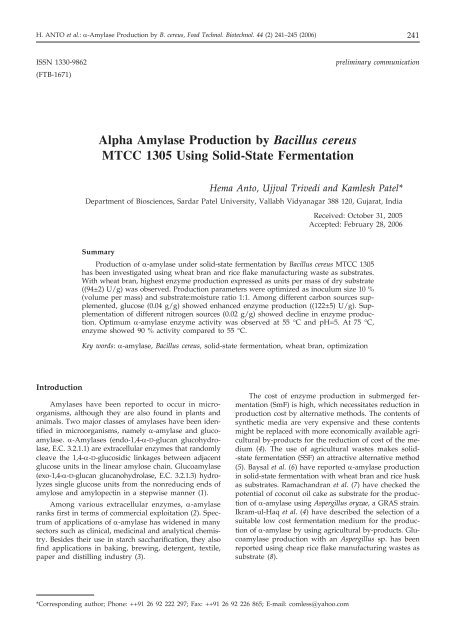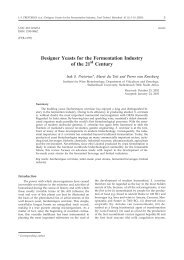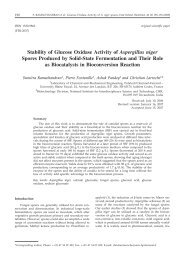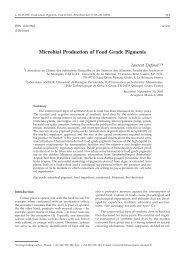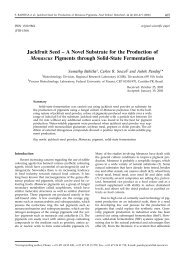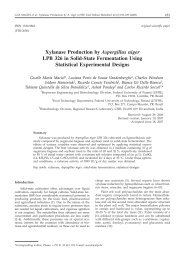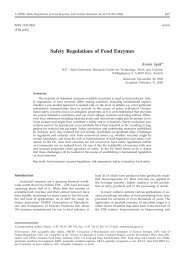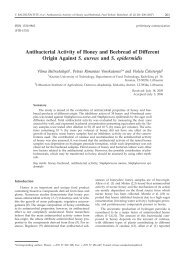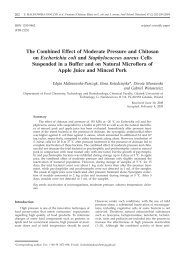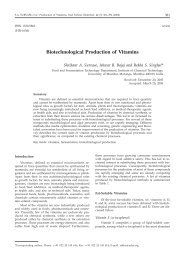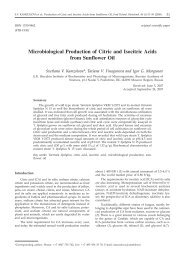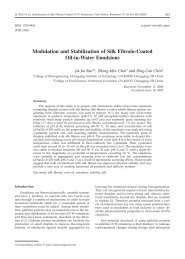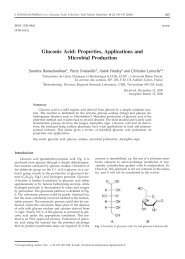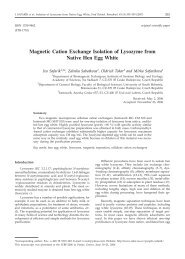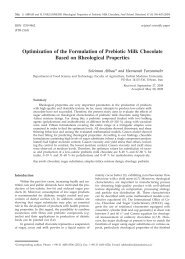Alpha Amylase Production by Bacillus cereus MTCC 1305 Using ...
Alpha Amylase Production by Bacillus cereus MTCC 1305 Using ...
Alpha Amylase Production by Bacillus cereus MTCC 1305 Using ...
Create successful ePaper yourself
Turn your PDF publications into a flip-book with our unique Google optimized e-Paper software.
H. ANTO et al.: a-<strong>Amylase</strong> <strong>Production</strong> <strong>by</strong> B. <strong>cereus</strong>, Food Technol. Biotechnol. 44 (2) 241–245 (2006)<br />
241<br />
ISSN 1330-9862<br />
(FTB-1671)<br />
preliminary communication<br />
<strong>Alpha</strong> <strong>Amylase</strong> <strong>Production</strong> <strong>by</strong> <strong>Bacillus</strong> <strong>cereus</strong><br />
<strong>MTCC</strong> <strong>1305</strong> <strong>Using</strong> Solid-State Fermentation<br />
Hema Anto, Ujjval Trivedi and Kamlesh Patel*<br />
Department of Biosciences, Sardar Patel University, Vallabh Vidyanagar 388 120, Gujarat, India<br />
Received: October 31, 2005<br />
Accepted: February 28, 2006<br />
Summary<br />
<strong>Production</strong> of a-amylase under solid-state fermentation <strong>by</strong> <strong>Bacillus</strong> <strong>cereus</strong> <strong>MTCC</strong> <strong>1305</strong><br />
has been investigated using wheat bran and rice flake manufacturing waste as substrates.<br />
With wheat bran, highest enzyme production expressed as units per mass of dry substrate<br />
((94±2) U/g) was observed. <strong>Production</strong> parameters were optimized as inoculum size 10 %<br />
(volume per mass) and substrate:moisture ratio 1:1. Among different carbon sources supplemented,<br />
glucose (0.04 g/g) showed enhanced enzyme production ((122±5) U/g). Supplementation<br />
of different nitrogen sources (0.02 g/g) showed decline in enzyme production.<br />
Optimum a-amylase enzyme activity was observed at 55 °C and pH=5. At 75 °C,<br />
enzyme showed 90 % activity compared to 55 °C.<br />
Key words: a-amylase, <strong>Bacillus</strong> <strong>cereus</strong>, solid-state fermentation, wheat bran, optimization<br />
Introduction<br />
<strong>Amylase</strong>s have been reported to occur in microorganisms,<br />
although they are also found in plants and<br />
animals. Two major classes of amylases have been identified<br />
in microorganisms, namely a-amylase and glucoamylase.<br />
a-<strong>Amylase</strong>s (endo-1,4-a-D-glucan glucohydrolase,<br />
E.C. 3.2.1.1) are extracellular enzymes that randomly<br />
cleave the 1,4-a-D-glucosidic linkages between adjacent<br />
glucose units in the linear amylose chain. Glucoamylase<br />
(exo-1,4-a-D-glucan glucanohydrolase, E.C. 3.2.1.3) hydrolyzes<br />
single glucose units from the nonreducing ends of<br />
amylose and amylopectin in a stepwise manner (1).<br />
Among various extracellular enzymes, a-amylase<br />
ranks first in terms of commercial exploitation (2). Spectrum<br />
of applications of a-amylase has widened in many<br />
sectors such as clinical, medicinal and analytical chemistry.<br />
Besides their use in starch saccharification, they also<br />
find applications in baking, brewing, detergent, textile,<br />
paper and distilling industry (3).<br />
The cost of enzyme production in submerged fermentation<br />
(SmF) is high, which necessitates reduction in<br />
production cost <strong>by</strong> alternative methods. The contents of<br />
synthetic media are very expensive and these contents<br />
might be replaced with more economically available agricultural<br />
<strong>by</strong>-products for the reduction of cost of the medium<br />
(4). The use of agricultural wastes makes solid-<br />
-state fermentation (SSF) an attractive alternative method<br />
(5). Baysal et al. (6) have reported a-amylase production<br />
in solid-state fermentation with wheat bran and rice husk<br />
as substrates. Ramachandran et al. (7) have checked the<br />
potential of coconut oil cake as substrate for the production<br />
of a-amylase using Aspergillus oryzae, a GRAS strain.<br />
Ikram-ul-Haq et al. (4) have described the selection of a<br />
suitable low cost fermentation medium for the production<br />
of a-amylase <strong>by</strong> using agricultural <strong>by</strong>-products. Glucoamylase<br />
production with an Aspergillus sp. has been<br />
reported using cheap rice flake manufacturing wastes as<br />
substrate (8).<br />
*Corresponding author; Phone: ++91 26 92 222 297; Fax: ++91 26 92 226 865; E-mail: comless@yahoo.com
242 H. ANTO et al.: a-<strong>Amylase</strong> <strong>Production</strong> <strong>by</strong> B. <strong>cereus</strong>, Food Technol. Biotechnol. 44 (2) 241–245 (2006)<br />
The most effective amylases are those that are thermostable<br />
(9). They are generally preferred as their application<br />
minimizes contamination risk and reduces reaction<br />
time, thus enabling considerable energy saving. Thermostable<br />
a-amylases are used for the liquefaction of starch at<br />
high temperature and thermolabile a-amylases are used<br />
for the saccharification of starch in baking (10). Babu and<br />
Satyanarayana (2) have reported production of a-amylase<br />
<strong>by</strong> a thermophilic <strong>Bacillus</strong> sp. and optimization of<br />
culture conditions for maximum enzyme production. Suitability<br />
of thermophilic <strong>Bacillus</strong> coagulans for a-amylase<br />
production <strong>by</strong> solid-state fermentation in flasks, reactor<br />
and trays has been reported (11).<br />
In the present study a-amylase production from <strong>Bacillus</strong><br />
<strong>cereus</strong> <strong>MTCC</strong> <strong>1305</strong> using solid-state fermentation<br />
has been investigated and the enzyme is reported to<br />
show activity at high temperature.<br />
Material and Methods<br />
Microorganism<br />
<strong>Bacillus</strong> <strong>cereus</strong> <strong>MTCC</strong> <strong>1305</strong> used in the present study<br />
was obtained from <strong>MTCC</strong>, Institute of Microbial Technology<br />
(IMTECH), Chandigarh, India. The culture was<br />
maintained on Bushnell Haas Agar (BHA) slants containing<br />
1 % starch at 4 °C.<br />
Solid-state fermentation<br />
Initial enzyme production was checked individually<br />
using wheat bran procured from local market and agroindustrial<br />
wastes generated during processing of rice to<br />
rice flakes. These two wastes were categorized as coarse<br />
and medium waste (8). Further optimization of process<br />
parameters was studied using wheat bran as substrate<br />
for solid-state fermentation.<br />
Development of the inoculum, enzyme production<br />
and extraction<br />
For the development of inoculum, culture was transferred<br />
from stock to 100-mL nutrient broth and the inoculated<br />
flasks were incubated overnight at (35±2) °C and<br />
150 rpm. Cells were harvested from the broth and their<br />
A was checked at 660 nm. Accordingly, cells with inoculum<br />
size of A 660 =0.5 (10 % inoculum (volume per mass))<br />
per5gofsubstrate were harvested, washed and resuspended<br />
in sterile distilled water. <strong>Production</strong> media contained<br />
5 g of solid substrate and 10 mL of Bushnell Haas<br />
(BH) mineral salt medium in 250-mL Erlenmeyer flasks<br />
and were inoculated with the above inoculum. Inoculated<br />
production media were incubated under static conditions<br />
at (35±2) °C and enzyme production was checked<br />
after every 24 h for 4 days. Enzyme was extracted in 50<br />
mL of 0.1 M phosphate buffer (pH=7) on a rotary shaker<br />
at 250 rpm for 30 min. The content was filtered through<br />
muslin cloth, filtrate was centrifuged at 8325 × g for 10<br />
min and clear brown supernatant was used as the enzyme<br />
source.<br />
a-<strong>Amylase</strong> enzyme assay<br />
a-<strong>Amylase</strong> activity was determined <strong>by</strong> incubating a<br />
mixture of 0.5 mL of aliquote of each enzyme source<br />
and 1 % soluble starch dissolved in 0.1 M phosphate<br />
buffer, pH=7, at 55 °C for 15 min (12). The reaction was<br />
stopped <strong>by</strong> adding 1 mL of 3,5-dinitrosalicylic acid, then<br />
followed <strong>by</strong> boiling for 10 min. The final volume was<br />
made up to 12 mL with distilled water and the reducing<br />
sugar released was measured at 540 nm (13). One unit<br />
(U) of a-amylase activity was defined as the amount of<br />
enzyme that releases 1 mmol of reducing sugar as glucose<br />
per minute, under assay conditions and expressed as<br />
U/g of dry substrate. All the experiments were performed<br />
in triplicates and the standard error has been reported.<br />
Optimization of cultural parameters<br />
Inoculum size was varied as 10, 20, 30 and 40 %<br />
(volume per mass) of inoculum, where 1 % (volume per<br />
mass) corresponds to cells with A 660 =1 of inoculum size<br />
added to 100 g of substrate. Substrate:moisture ratio<br />
was maintained as 1:1, 1:1.5, 1:2 and 1:2.5 and the enzyme<br />
production was checked using wheat bran as substrate<br />
and BH mineral salt medium as moistening agent.<br />
Effect of additional nutrients<br />
Carbon sources (0.04 g/g dry substrate) as glucose,<br />
soluble starch, maltose and sucrose, and nitrogen sources<br />
(0.02 g/g dry substrate) as casein, NH 4 Cl, yeast extract<br />
and urea were supplemented as individual components<br />
to the production media to check their effect on enzyme<br />
production.<br />
Effect of temperature and pH on enzyme activity<br />
To determine temperature activity profile for an<br />
a-amylase enzyme, assay was carried out at 35, 55 and<br />
75 °C. For determination of suitable pH range for enzyme<br />
activity, pH of enzyme assay buffers (0.1 M) was<br />
varied as 5 (acetate buffer), 7 and 9 (phosphate buffer).<br />
Results and Discussion<br />
<strong>Bacillus</strong> species are considered to be the most important<br />
sources of a-amylase and have been used for enzyme<br />
production using SSF (1). <strong>Production</strong> of pullulanase<br />
and -amylase using <strong>Bacillus</strong> <strong>cereus</strong> has been studied<br />
(1,9). Wheat bran and two waste products obtained while<br />
processing of rice to rice flakes, coarse waste and medium<br />
waste were evaluated for a-amylase production <strong>by</strong><br />
solid-state fermentation. Among the three substrates tested<br />
highest enzyme production was observed with wheat<br />
bran ((94±2) U/g) (Table 1). Maximum enzyme produc-<br />
Table 1. <strong>Production</strong> of a-amylase (U/g) <strong>by</strong> <strong>Bacillus</strong> <strong>cereus</strong> <strong>MTCC</strong><br />
<strong>1305</strong> on different substrates <strong>by</strong> solid-state fermentation<br />
Hours<br />
Wheat<br />
bran<br />
Substrates<br />
Coarse rice<br />
waste<br />
Medium rice<br />
waste<br />
Enzyme production/(U/g)<br />
24 20±2 7±2 13±2<br />
48 70±2 25±2 15±2<br />
72 94±2 34±2 19±1<br />
96 55±3 16±3 7±2
H. ANTO et al.: a-<strong>Amylase</strong> <strong>Production</strong> <strong>by</strong> B. <strong>cereus</strong>, Food Technol. Biotechnol. 44 (2) 241–245 (2006)<br />
243<br />
tion was observed after 72 h, which decreased with further<br />
incubation. Among the two rice flake manufacturing wastes<br />
tested, coarse waste gave good enzyme production and<br />
further studies are required for efficient utilization of this<br />
waste generated in large quantities during the rice processing.<br />
Though rice flake manufacturing wastes were<br />
proved promising substitutes for wheat bran in glucoamylase<br />
production using fungal culture in our previous<br />
studies (8), the presence of husk particles along with<br />
broken rice in the wastes might have resulted in lower<br />
growth and enzyme production compared to wheat bran.<br />
Ikram-ul-Haq et al. (4) have reported wheat bran as the<br />
best substrate for a-amylase production <strong>by</strong> <strong>Bacillus</strong> licheniformis<br />
using different agricultural <strong>by</strong>-products. In our<br />
subsequent optimization studies, wheat bran was used<br />
as the substrate for the production of a-amylase.<br />
Varying inoculum size of bacterial cells during the<br />
fermentation indicated 10 % (volume per mass) inoculum<br />
as optimum for the enzyme production (Fig. 1). Increase<br />
in inoculum size was found to adversely affect<br />
the enzyme production. As the moisture content of the<br />
medium changes during fermentation as a result of evaporation<br />
and metabolic activities, adjusting the optimum<br />
moisture level of substrate during SSF is therefore most<br />
important (6). During solid-state fermentation, higher<br />
moisture level decreases porosity, changes wheat bran<br />
particle structure, promotes development of stickiness<br />
and lowers oxygen transfer (14,15), whereas lower moisture<br />
content causes reduction in the solubility of nutrients<br />
of the solid substrate, lower degree of swelling and<br />
higher water tension (15). In the present study, high enzyme<br />
titer was obtained when the substrate:moisture ratio<br />
was maintained as 1:2 in comparison with that of low<br />
or high moisture levels. Maximum a-amylase enzyme production<br />
<strong>by</strong> thermophilic B. coagulans has been reported<br />
using a high level of moisture at 1:2.5 ratio of substrate:moisture<br />
content (11).<br />
Enzyme production/(U/g)<br />
120<br />
100<br />
80<br />
60<br />
40<br />
20<br />
0<br />
10 % 20 % 30 % 40 %<br />
Inoculum size/(volume per mass)<br />
Fig. 1. Effect of inoculum size on the production of a-amylase<br />
(U/g) <strong>by</strong> <strong>Bacillus</strong> <strong>cereus</strong> <strong>MTCC</strong> <strong>1305</strong> under solid-state fermentation<br />
using wheat bran as substrate<br />
Supplementation of carbon sources in the form of<br />
monosaccharides, disaccharides and polysaccharides resulted<br />
in marginal increase in a-amylase production <strong>by</strong><br />
B. <strong>cereus</strong> during solid-state fermentation using wheat bran.<br />
Highest production was observed with glucose ((122±5)<br />
U/g) (Fig. 2). <strong>Bacillus</strong> thermooleovorans is reported to prefer<br />
starch, glucose, lactose, maltose and maltodextrins as<br />
Enzyme pro uction/(U/g)<br />
d<br />
140<br />
120<br />
100<br />
80<br />
60<br />
40<br />
20<br />
0<br />
Control Glucose Starch Maltose Sucrose<br />
Carbon sources/(0.04 g/g)<br />
Fig. 2. Effect of carbon source (0.04 g/g) supplementation on<br />
a-amylase (U/g) production <strong>by</strong> <strong>Bacillus</strong> <strong>cereus</strong> <strong>MTCC</strong> <strong>1305</strong> under<br />
solid-state fermentation using wheat bran as substrate<br />
carbon sources for a-amylase secretion (16). In contrast,<br />
carbon sources such as glucose, maltose and starch did not<br />
enhance a-amylase production <strong>by</strong> thermophilic B. coagulans<br />
in solid-state fermentation using wheat bran (11).<br />
Addition of organic nitrogen sources such as casein, yeast<br />
extract and urea, and inorganic nitrogen source such as<br />
ammonium chloride to the medium resulted in considerable<br />
decrease in a-amylase production <strong>by</strong> B. <strong>cereus</strong><br />
(Fig. 3). Supplementation of additional nitrogen sources<br />
in general has been reported to be inhibitory for a-amylase<br />
production <strong>by</strong> microorganisms. Presence of organic<br />
nitrogen sources, urea and peptone, has been reported<br />
to enhance a-amylase enzyme production <strong>by</strong> Aspergillus<br />
niger in wheat bran containing solid substrate medium,<br />
but inorganic nitrogen source, ammonium chloride, repressed<br />
enzyme production (17). Decrease in a-amylase<br />
enzyme production during solid-state fermentation when<br />
using organic nitrogen sources like casein, gelatin and<br />
soy meal as medium supplements has been reported (18).<br />
Enzyme pro uction/(U/g)<br />
d<br />
120<br />
100<br />
80<br />
60<br />
40<br />
20<br />
0<br />
Control Casein Ammonium<br />
chloride<br />
Yeast<br />
extract<br />
Nitrogen sources/(0.02 g/g)<br />
Urea<br />
Fig. 3. Effect of nitrogen source (0.02 g/g) supplementation on<br />
a-amylase (U/g) production <strong>by</strong> <strong>Bacillus</strong> <strong>cereus</strong> <strong>MTCC</strong> <strong>1305</strong> under<br />
solid-state fermentation using wheat bran as substrate<br />
As starch liquefaction is generally carried out at higher<br />
temperatures of 70–90 °C, the thermostable a-amylases<br />
are of great significance (19). In this study a-amylase
244 H. ANTO et al.: a-<strong>Amylase</strong> <strong>Production</strong> <strong>by</strong> B. <strong>cereus</strong>, Food Technol. Biotechnol. 44 (2) 241–245 (2006)<br />
produced <strong>by</strong> B. <strong>cereus</strong> showed considerable enzyme activity<br />
in the ranges from lower to higher temperature<br />
(Fig. 4). At 75 °C, 90 % activity was observed compared<br />
to the optimum enzyme activity at 55 °C. For a-amylase<br />
produced <strong>by</strong> a laboratory <strong>Bacillus</strong> isolate AS-1, 88, 85 and<br />
44 % of activity has been reported at 60, 70 and 80 °C,<br />
respectively (19). Thus, further studies on the thermal<br />
stability of a-amylase enzyme produced <strong>by</strong> B. <strong>cereus</strong> <strong>MTCC</strong><br />
<strong>1305</strong> have to be carried out to confirm its applications<br />
for starch liquefaction. Presence of metal ions like Ca 2+<br />
and Mg 2+ known to improve the thermal stability may<br />
show promising results.<br />
Enzyme activity/(U/g)<br />
120<br />
100<br />
80<br />
60<br />
40<br />
20<br />
0<br />
Maximum enzyme activity was observed at pH=5<br />
((96±2) U/g) (Fig. 5). The use of alkaline buffer (pH=9)<br />
for enzyme reaction resulted in a sharp decline in the<br />
enzyme activity. a-<strong>Amylase</strong> of <strong>Bacillus</strong> sp. AS-1 is reported<br />
to have pH optimum at pH=6.5 and 98 % peak<br />
activity at pH=6 and 7. The same enzyme has also been<br />
shown efficient for liquefaction of gelatinized starch because<br />
of its thermal stability (19).<br />
Conclusion<br />
35 55 75<br />
Temperature/ C<br />
Fig. 4. a-<strong>Amylase</strong> enzyme activity (U/g) of <strong>Bacillus</strong> <strong>cereus</strong> <strong>MTCC</strong><br />
<strong>1305</strong> at three different temperatures<br />
Enzyme activity/(U/g)<br />
120<br />
100<br />
80<br />
60<br />
40<br />
20<br />
0<br />
5 7 9<br />
pH<br />
Fig. 5. a-<strong>Amylase</strong> enzyme activity (U/g) of <strong>Bacillus</strong> <strong>cereus</strong> <strong>MTCC</strong><br />
<strong>1305</strong> at three different pH values<br />
The results obtained in the present study indicated<br />
<strong>Bacillus</strong> <strong>cereus</strong> <strong>MTCC</strong> <strong>1305</strong> as a potential strain for a-amylase<br />
production using solid-state fermentation with wheat<br />
bran as substrate. Interesting observation was that it<br />
showed and retained 90 % enzyme activity at 75 °C<br />
compared to the optimum at 55 °C. Furthermore, the enzyme<br />
was found to show optimum activity under acidic<br />
condition (pH=5). This makes the a-amylase of the organism<br />
useful for various industrial applications like starch<br />
liquefaction at increased temperatures.<br />
Acknowledgement<br />
Hema Anto is thankful to the Gujarat Government<br />
for financial assistance during this work through Gujarat<br />
Research Fellowship.<br />
References<br />
1. A. Pandey, P. Nigam, C.R. Soccol, V.T. Soccol, D. Singh, R.<br />
Mohan, Advances in microbial amylases, Biotechnol. Appl.<br />
Biochem. 31 (2000) 135–152.<br />
2. K.R. Babu, T. Satyanarayana, Parametric optimization of<br />
extracellular a-amylase production <strong>by</strong> thermophilic <strong>Bacillus</strong><br />
coagulans, Folia Microbiol. 38 (1993) 77–80.<br />
3. S. Ramachandran, A.K. Patel, K.M. Nampoothiri, S. Chandran,<br />
G. Szakacs, C.R. Soccol, A. Pandey, <strong>Alpha</strong> amylase<br />
from a fungal culture grown on oil cakes and its properties,<br />
Braz. Arch. Biol. Technol. 47 (2004) 309–317.<br />
4. Ikram-ul-Haq, H. Ashraf, J. Iqbal, M.A. Qadeer, <strong>Production</strong><br />
of alpha amylase <strong>by</strong> <strong>Bacillus</strong> licheniformis using an economical<br />
medium, Bioresour. Technol. 87 (2003) 57–61.<br />
5. P. Ellaiah, K. Adinarayana, Y. Bhavani, P. Padmaja, B. Srinivasulu,<br />
Optimization of process parameters for glucoamylase<br />
production under solid state fermentation <strong>by</strong> a<br />
newly isolated Aspergilus species, Process Biochem. 38 (2002)<br />
615–620.<br />
6. Z. Baysal, F. Uyar, C. Aytekin, Solid-state fermentation for<br />
production of a-amylase <strong>by</strong> a thermotolerant <strong>Bacillus</strong> subtilis<br />
from hot-spring water, Process Biochem. 38 (2003) 1665–<br />
1668.<br />
7. S. Ramachandran, A.K. Patel, K.M. Nampoothiri, F. Francis,<br />
V. Nagy, G. Szakacs, A. Pandey, Coconut oil cake – A<br />
potential raw material for the production of a-amylase, Bioresour.<br />
Technol. 93 (2004) 169–174.<br />
8. H. Anto, U.B. Trivedi, K.C. Patel, Glucoamylase production<br />
<strong>by</strong> solid-state fermentation using rice flake manufacturing<br />
waste products as substrate, Bioresour. Technol. 97<br />
(2006) 1161–1166.<br />
9. P. Nigam, D. Singh, Enzyme and microbial systems involved<br />
in starch processing, Enzyme Microb. Technol. 17<br />
(1996) 770–779.<br />
10. J.F. Shaw, F.P. Lin, S.C. Chen, H.C. Chen, Purification and<br />
properties of an extracellular a-amylase from Thermus sp.,<br />
Bot. Bull. Acad. Sin. 36 (1995) 195–200.<br />
11. K.R. Babu, T. Satyanarayana, a-<strong>Amylase</strong> production <strong>by</strong> thermophilic<br />
<strong>Bacillus</strong> coagulans in solid state fermentation, Process<br />
Biochem. 30 (1995) 305–309.<br />
12. P. Bernfield: <strong>Amylase</strong>s, a and . In: Methods in Enzymology,<br />
Vol. 1, Academic Press, New York, USA (1955) pp.<br />
149–158.<br />
13. G.L. Miller, Use of dinitrosalicylic acid reagent for determination<br />
of reducing sugars, Anal. Chem. 31 (1959) 426–<br />
428.<br />
14. B.K. Lonsane, N.P. Ghildyal, S. Budiatman, S.V. Ramakrishna,<br />
Engineering aspects of solid state fermentation, Enzyme<br />
Microb. Technol. 7 (1985) 258–265.<br />
15. F. Zadrazil, H. Brunnert, Investigations on physical parameters<br />
important for the SSF of straw <strong>by</strong> white rot fungi,<br />
Eur. J. Appl. Microbiol. Biotechnol. 11 (1981) 183–188.
H. ANTO et al.: a-<strong>Amylase</strong> <strong>Production</strong> <strong>by</strong> B. <strong>cereus</strong>, Food Technol. Biotechnol. 44 (2) 241–245 (2006)<br />
245<br />
16. S. Narang, T. Satyanarayana, Thermostable a-amylase production<br />
<strong>by</strong> an extreme thermophile <strong>Bacillus</strong> thermooleovorans,<br />
Lett. Appl. Microbiol. 32 (2001) 31–35.<br />
17. P. Kaur, H.S. Grewal, G.S. Kocher, <strong>Production</strong> of a-amylase<br />
<strong>by</strong> Aspergillus niger using wheat bran in submerged<br />
and solid state fermentations, Indian J. Microbiol. 43 (2003)<br />
143–145.<br />
18. V.H. Mulimani, G.N. Patil Ramalingam, a-<strong>Amylase</strong> production<br />
<strong>by</strong> solid state fermentation: A new practical approach<br />
to biotechnology courses, Biochem. Educ. 28 (2000)<br />
161–163.<br />
19. S.K. Soni, A. Kaur, J.K. Gupta, A solid state fermentation<br />
based bacterial a-amylase and fungal glucoamylase system<br />
and its suitability for the hydrolysis of wheat starch,<br />
Process Biochem. 39 (2003) 185–192.
FTB 44 (2) 241-245.<br />
Proizvodnja α-amilaze uzgojem na čvrstoj podlozi s pomoću soja<br />
<strong>Bacillus</strong> <strong>cereus</strong> <strong>MTCC</strong> <strong>1305</strong><br />
Sažetak<br />
Istražen je postupak proizvodnje α-amilaze uzgojem bakterijskog soja <strong>Bacillus</strong> <strong>cereus</strong><br />
<strong>MTCC</strong> <strong>1305</strong> na čvrstoj podlozi od pšeničnih posija i otpada dobivenog pri proizvodnji rižinih<br />
pahuljica. Uporabom pšeničnih posija postignuta je najveća proizvodnja enzima od (94±2)<br />
U/g suhe tvari. Optimirani su uvjeti proizvodnje, i to udio inokuluma od 10 % (V/m) i omjer<br />
čvrstog supstrata i vode od 1:1. Primjenom glukoze (0,04 g/g) kao izvora ugljika povećana je<br />
proizvodnja enzima na (122±5) U/g. Dodatkom različitih izvora dušika (0,02 g/g) smanjena je<br />
proizvodnja enzima. Optimalna je aktivnost α-amilaze bila pri 55 °C i pH=5. Pri 75 °C enzim<br />
je pokazao 90 % aktivnosti od one pri 55 °C.


